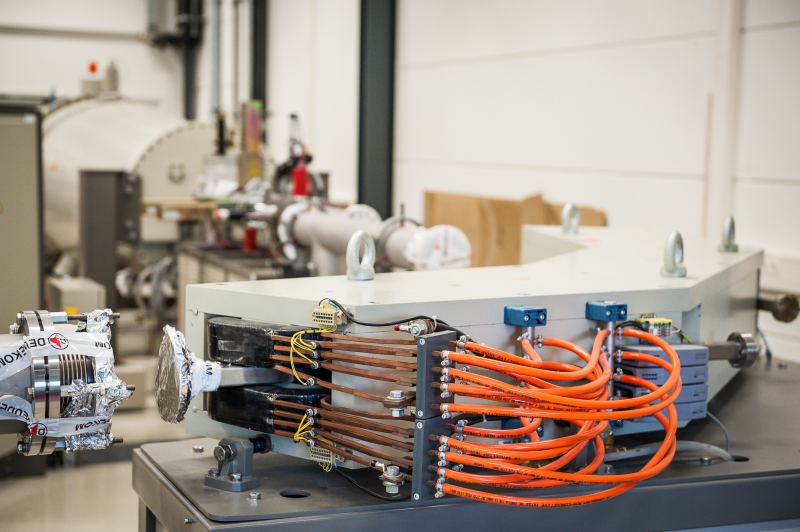DIFFER's facility Magnum-PSI produced its first plasma on Wednesday 8 June 2016, a major milestone in the relocation of this unique experiment for fusion wall materials. Magnum-PSI will be fully operational again at the end of 2016, and is the only laboratory setup in the world capable of investigating candidate materials under the realistic conditions for future fusion experiments like ITER. These materials face conditions similar to those at the surface of the sun. Later this year, Magnum-PSI will be upgraded with a superconducting magnet to allow for record-breaking long term exposure of materials to such intense plasma's.

First plasma (left) in DIFFER's facility Magnum-PSI for extreme plasma surface interactions. Magnum-PSI (without magnet system in this picture) is the only laboratory setup in the world capable of investigating candidate materials under the realistic conditions for future fusion experiments like ITER. credit photo Magnum-PSI: Bram Lamers / DIFFER
Wall materials for an artificial sun
Fusion research aims to turn the process which powers the sun into a clean, safe and sustainable energy source on earth. The next step in fusion is the multinational ITER project, currently under construction in the south of France and designed as the first reactor to produce more energy from fusion than needed to sustain the reactions.
For the power plants beyond ITER, the question of which materials and designs can handle the harsh conditions in the reactor for months on end is still an open question. In ITER, the wall of the exhaust needs to withstand punishing heat loads of 10-20 MW/m2 while being bombarded with 1021 charged particles/m2 every second, as well as short outbursts from the plasma up to 1000 MW/m2. Magnum-PSI is the only device in the world which can reach and exceed those plasma conditions to test candidate wall materials.

Artist's concept of the ITER fusion reactor and its exhaust or divertor, which acts to remove the helium 'ash' from the reactor. The divertor is the only part of the reactor wall where the magnetic field cage allows the plasma to come into direct contact with the hot plasma.
What's next: diagnostics and superconducting magnet upgrade
"This first plasma in Magnum-PSI is a great achievement on the way to full scientific operations", says DIFFER's head of fusion facilities Hans van Eck. Creating the first plasma required the team to bring many different systems online: the plasma source, vacuum pumps, cooling systems and data acquisition and control system. In the following months the Magnum-PSI team will install diagnostics to monitor plasma conditions and target materials. Magnum-PSI will also be connected to the new Ion Beam Facility for (sub)surface materials research that DIFFER is building up. At the new site, Magnum-PSI is undergoing a major upgrade with a superconducting magnet system to replace the conventional pulsed electromagnets. "This superconducting magnet will allow for truly long term exposure of materials to the plasma", says Hans van Eck. This will enable the world's first ever experiments on how material properties evolve during the long timescales expected in ITER. Thomas Morgan, heading the plasma materials interactions research at DIFFER: "Magnum-PSI's superconducting upgrade will open up a wholly new regime where we can, for the first time, see how the material behaviour will change as the surface evolves on long timescales under relevant plasma conditions."
At the new site, Magnum-PSI is undergoing a major upgrade with a superconducting magnet system to replace the conventional pulsed electromagnets. "This superconducting magnet will allow for truly long term exposure of materials to the plasma", says Hans van Eck. This will enable the world's first ever experiments on how material properties evolve during the long timescales expected in ITER. Thomas Morgan, heading the plasma materials interactions research at DIFFER: "Magnum-PSI's superconducting upgrade will open up a wholly new regime where we can, for the first time, see how the material behaviour will change as the surface evolves on long timescales under relevant plasma conditions."
DIFFER's new Ion Beam Facility (upper left) will be a major addition to Magnum-PSI's diagnostic park for materials research
Eager to start again
In its 2.5 year run of experiments previous to DIFFER's relocation, Magnum-PSI has already produced exciting results for the fusion community and beyond. External users like ITER, the Princeton Plasma Physics Lab and the European Horizon2020 consortium for fusion EUROfusion are eager to visit the upgraded facility for joint experiments.
Read more about the research results from Magnum-PSI
Go to the News page.